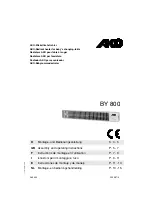
18
Note:
An alternative approach for sizing discharge pipes would be to follow Annex D, section
D.2 of BS 6700:2006 + A1:2009 Specification for design, installation, testing and maintenance of
services supplying water for domestic use within buildings and their curtilages.
3.59
Where a single common discharge pipe serves more than one system, it should be at least
one pipe size larger than the largest individual discharge pipe (D2) to be connected.
3.60
The discharge pipe should not be connected to a soil discharge stack unless it can be
demonstrated that the soil discharge stack is capable of safely withstanding temperatures of the
water discharged, in which case, it should:
a. contain a mechanical seal, not incorporating a water trap, which allows water into the branch
pipe without allowing foul air from the drain to be ventilated through the
tundish;
b. be a separate branch pipe with no
sanitary appliances
connected to it;
c. if plastic pipes are used as branch pipes carrying discharge from a safety device, they should
be either polybutalene (PB) or crosslinked polyethylene (PE-X) complying with national stand-
ards such as Class S of BS 7291-2:2006 or Class S of BS 7291-3:2006 respectively; and
d. be continuously marked with a warning that no
sanitary appliances
should be connected to
the pipe.
Notes:
1. Plastic pipes should be joined and assembled with fittings appropriate to the circumstances
in which they are used as set out in BS EN ISO 1043-1:2002 Plastics. Symbols and abbreviated
terms. Basic polymers and their special characteristics.
2. Where pipes cannot be connected to the stack it may be possible to route a dedicated pipe
alongside or in close proximity to the discharge stack.
Termination of discharge pipe
3.61
The discharge pipe (D2) from the tundish should terminate in a safe place where there is no
risk to persons in the vicinity of the discharge.
3.62
Examples of acceptable discharge arrangements are:
a. to a trapped gully with the end of the pipe below
a fixed grating and above the water seal;
b. downward discharges at low level; i.e. up to 100mm above external surfaces such as car
parks, hard standings, grassed areas etc. are acceptable providing that a wire cage or similar
guard is positioned to prevent contact, whilst maintaining visibility; and,
c. discharges at high level: e.g. into a metal hopper and metal downpipe with the end of the dis-
charge pipe clearly visible or onto a roof capable of withstanding high temperature discharges of
water and 3 m from any plastic guttering system that would collect such discharges.
3.63
The discharge would consist of high temperature water and steam. Asphalt, roofing felt and
nonmetallic rainwater goods may be damaged by such discharges.
Summary of Contents for Flexistor 1000
Page 30: ...30 38 Part No 95 607 690 46 Part No 95 980 009 2 1 34 1 46 ...
Page 31: ...31 48 38 30 38 31 32 ...
Page 32: ...32 ...
Page 33: ...33 ...
















































